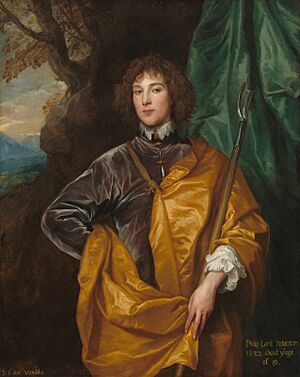Philip Wharton, 4th Baron Wharton facts for kids

Philip Wharton, 4th Baron Wharton (born April 18, 1613 – died February 4, 1696) was an important English soldier, politician, and diplomat. He was a strong supporter of Parliament during the English Civil War, often called a Roundhead.
Philip Wharton was the son of Sir Thomas Wharton and Lady Philadelphia Carey. His father passed away in 1622. Philip became a Baron when his grandfather died in 1625, inheriting the title.
Contents
Philip Wharton's Role in Parliament
Philip Wharton was a key figure in Parliament. In July 1642, Parliament chose him to be the Lord Lieutenant of Buckinghamshire. This meant he was in charge of the local military forces.
He led soldiers to take control of the local magazine (a place where weapons and supplies are stored) in Manchester. Manchester was a town that strongly supported the Puritans. However, Lord Strange arrived first. Even so, some local people fought back against Lord Strange's entry. This event was one of the first small battles of the First English Civil War.
Wharton also served on the Committee for Both Kingdoms. This committee worked to unite the Scottish Covenanters and the English Parliament. He was a Puritan and was well-liked by Oliver Cromwell, a very powerful leader of the Parliamentarian side.
Life After the Monarchy Returned
After the monarchy was brought back to England (this was called the Restoration), Philip Wharton often had problems with the King. In 1676, he was put in the Tower of London. Later, in 1685, he had to leave the country when King James II became king.
While he was living abroad, he spent time at the court of the Prince of Orange. When the Prince of Orange became King of England in 1688, Wharton and his family were back in royal favor. Philip Wharton always admired Oliver Cromwell. He strongly believed that Parliament was right during the Civil War. In 1689, he even demanded that Henry Hyde, 2nd Earl of Clarendon take back a comment that called the Civil War a rebellion.
Philip Wharton's Family Life
Philip Wharton had a daughter named Elizabeth with his first wife, Elizabeth Wandesford.
With his second wife, Jane Goodwin, he had seven more children: Anne, Margaret, Thomas Wharton, 1st Marquess of Wharton, Mary, Goodwin, Philadelphia, and Henry. Jane passed away in 1658.
In 1661, he married for a third time to Anne Popham. Anne was the widow of Colonel Edward Popham. She had two children from her previous marriage: Letitia and Alexander. Alexander was deaf, and with the help of Dr. John Wallis in Oxford, he became one of the first deaf people to learn to speak. Philip and Anne had one son together named William, who sadly died in a duel in 1687.

Art and Charity Work
Lord Wharton was a big supporter of art. In the 1630s, he asked the famous artist Anthony van Dyck to paint portraits of his family, including himself, his wife Jane, and his daughters.
He also gave a lot of support to church ministers, especially those who shared his religious views. He helped build chapels in Ravenstonedale and Smarber and provided money for the ministers there. One of these chapels, Low Row United Reformed Church, is still active today.
In his will, Lord Wharton left land near York to create a special Bible charity. This charity gives Bibles to children to use outside of church or school. The will states that children who receive a Bible must learn certain psalms by heart. The charity also includes the Shorter Catechism. Thousands of Bibles have been given out over the years, and the Trust still gives Bibles to young people under eighteen. You can learn more at lordwhartonbibles.org.uk.

